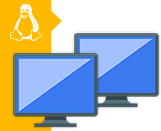NoMachine for Linux - i686

Version:
8.11.3_4
Package size:
51.77 MB
Package type:
TAR.GZ
MD5 signature:
177aa92dde10b832fb96553c5c973c51
For:
RHEL 6.0 to RHEL 9, CentOS 6.0 to CentOS 8.5, CentOS Stream 8 to CentOS Stream 9, SLED 11 to SLED 15, SLES 11 to SLES 15, openSUSE 11.x to openSUSE 15.x, Fedora 10 to Fedora 39, Debian 5 to Debian 12, Ubuntu 8.04 to Ubuntu 23.10

The free NoMachine product is designed to work the same across Windows, Mac and Linux and give users access to the physical desktop of the remote computer. If you need to create virtual Linux desktops on demand, want to limit the logins to SSH, or are using NIS, Kerberos or other enterprise functionalities, you need one of the NoMachine Enterprise products you can download here.
Note that you can use NoMachine 8 as a client of a NoMachine server, or you can download the free Enterprise client here.
|




